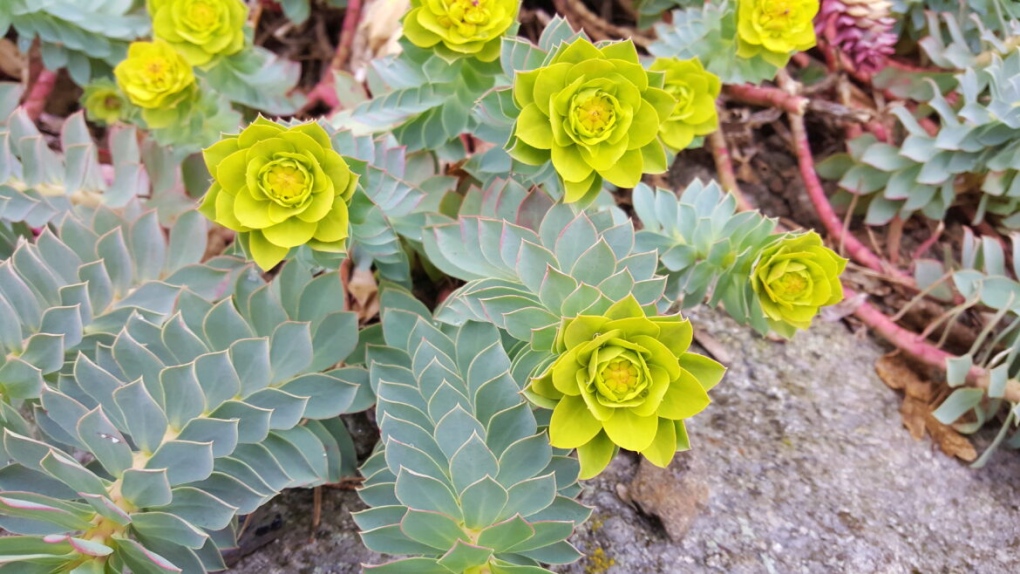Myrtle spurge: B.C. children left burned by invasive plant
 Two children suffering from the effects of Myrtle spurge contact are seen in an image from the Invasive Species Council of B.C.
Two children suffering from the effects of Myrtle spurge contact are seen in an image from the Invasive Species Council of B.C.
The Invasive Species Council of B.C. is asking the public to report sightings of a "highly toxic" plant that can leave people's skin blistered and burned – something one family recently learned the hard way.
Okanagan residents Doug and Sandra Nimmo were hosting their granddaughters over the July long weekend when the children came into contact with Myrtle spurge, a garden perennial that carries a nasty sap capable of causing blindness in severe cases.
Fortunately, the children, who had been picking plants for a bouquet, only woke up the next morning with red and irritated skin, according to the Invasive Species Council, which shared the family's story.
"They got out of bed, and I was shocked to see their faces puffed up with blisters," Sandra Nimmo told the ISCBC, adding that the children weren’t seriously hurt.
“They laughed when they saw their faces in the mirror, and it only took about a week and a half to clear their skin.”
Myrtle spurge, or euphorbia myrsinites, is described as an extremely aggressive invasive species from the Mediterranean that can quickly take over gardens and other green spaces.
If ingested, the plant can cause nausea, vomiting and diarrhea. To cause blindness, the sap has to come into contact with someone's eyes.
The Invasive Species Council said Myrtle spurge is recognizable by its small, yellow flowers and light blue-green leaves, which are sharp and spiral closely around the stem. The plant grows 10 to 15 cm tall and forms a "low, spreading mound," according to the ISCBC.
 Myrtle spurge is seen in an image from the Invasive Species Council of B.C.
Myrtle spurge is seen in an image from the Invasive Species Council of B.C.
The plants are mostly found in the Okanagan, where they thrive in its warm climate and dry soil. They’re also sometimes found for sale at garden centres, despite being provincially regulated.
"With our PlantWise program, we are working with growers, retailers, and consumers to spread the word about which invasive species shouldn’t be sold and grown in B.C.," ISCBC's Allison McCabe said in a statement. "Great alternatives to Myrtle spurge include Lanceleaf Stonecrop (sedum lanceolatum), a beautiful native succulent that thrives in hot, dry conditions.”
The Invasive Species Council of B.C. said people can find more alternatives through its Grow Me Instead website. Anyone who has been in contact with Myrtle spurge or another invasive species is urged to report it online.
CTVNews.ca Top Stories

Trudeau, Carney push back over Trump's ongoing 51st state comments
Two senior members of the federal cabinet were in Florida Friday pushing Canada's new border plan with Donald Trump's transition team, a day after Trudeau himself appeared to finally push back at the president-elect over his social media posts about turning Canada into the 51st state.
B.C. man charged with dangerous driving after elderly Good Samaritan killed in crash
A man is facing multiple charges of dangerous driving following a collision that led to the death of an 80-year-old Good Samaritan on Vancouver Island, B.C.
Five southern Ont. hunters fined $37K for moose hunt offences in northern Ont.
A multi-year moose hunting investigation resulted in five people being convicted of moose hunting offences and fined a total of $37,000, plus $9,250 in victim surcharges.
Whooping cough is on the rise in the States. What's happening in Canada?
Canadian health officials say they're seeing spikes in whooping cough cases in parts of the country as the U.S. deals with case numbers not seen in more than a decade.
Halifax Thunderbirds player Tyson Bell suspended, cited for assault in Colorado
The Halifax Thunderbirds has suspended player Tyson Bell following an alleged assault in Colorado.
Gerry Butts says Trudeau less likely to remain leader since Freeland quit
A former chief adviser and close friend to Prime Minister Justin Trudeau says he doesn't think Trudeau will stay on to lead the Liberals in the next election.
Freezing drizzle, brutal cold: Weekend weather forecast wrap
From freezing rain to brutal cold, wintry conditions are in the forecast across Canada this weekend.
Tugboats, crews try to refloat ship stuck in St. Lawrence River near Montreal
A team of tugboats is being deployed to refloat a ship that has been stuck in the St. Lawrence River northeast of Montreal since Christmas Eve.
9-year-old girl dead in Calgary Boxing Day crash
A nine-year-old girl has died in hospital after the vehicle she was in was struck by a driver in a stolen vehicle fleeing from police.































